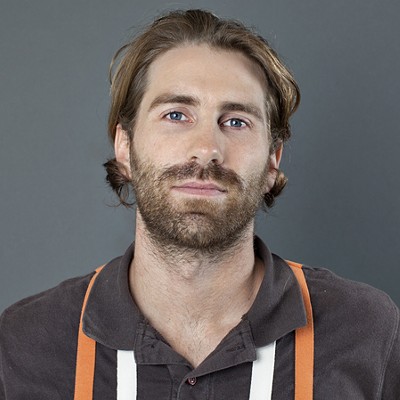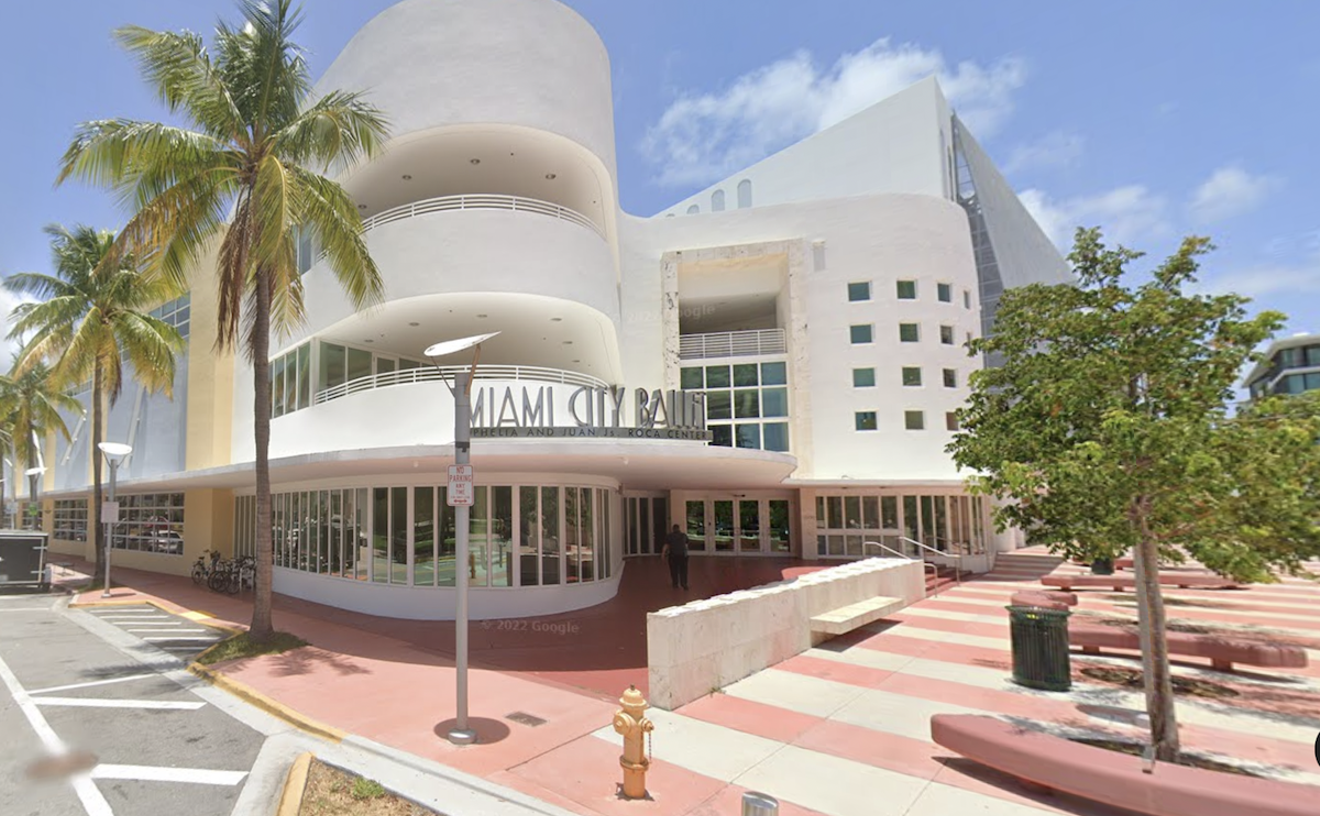On a beautiful Tuesday evening in North Miami-Dade at the Ives Estates Tennis Center, just off Ives Dairy Road, four men bat a ball around a wire and glass box about the size of a large backyard swimming pool. Using 18-inch paddles that look from afar like mini-tennis rackets, they smack forehands, retrieve lobs, and lunge for drop shots as Latin pop ballads play in the background. They serve underhand and, when caught out of position, defend by banking shots hard against the back wall so the ball deflects back across the net.
After a long exchange, one player -- a tanned, paunchy man with disheveled hair spilling out of a backward cap -- rushes the net. On the other side, just a few feet away, is his handsome, dark-featured opponent. The ball hangs high in the air, and the man in the backward hat reaches up and smashes a forehand volley, hard. The ball strikes the dark-featured man near the groin, and all four players burst into yelps and hollers. "You had the whole court!" shouts the dark-featured man in Spanish. "Shit!"
The four men -- an accountant, a realtor, a soap opera actor, and a culinary student -- are playing pádel, a kind of tennis-racquetball hybrid that's immensely popular in some parts of Latin American and Europe. In Spain, the current epicenter of the sport, nearly every new apartment building comes with a court on top, and some estimates count 8 million players, which would make pádel more popular than anything except soccer.
In the United States, the sport is virtually nonexistent. But it's about to get a lot more visible in Miami. A new club on NE 17th Street and Second Avenue -- the third in the area and first near downtown -- is slated to open to the public November 14. "We're going to create a demand in the United States," says Luís Ibañez, the new club's founder. "It's really addictive, and it's really gratifying."
Pádel is always played in doubles. It employs regular tennis balls and scoring, but the court is considerably smaller, and the underhand serving and use of paddles instead of racquets means points tend to last a lot longer.
Compared to tennis, there's more emphasis on control and placement, less on power and athleticism, making the sport inherently easier for recreational players. "The good thing is that you don't have to be good to have fun," says Gustavo Tosti, a realtor and Buenos Aires native who's a regular in North Miami-Dade. "If you play tennis--if you are not good, all the time you are just picking up balls."
Pádel, according to most accounts, was born in Acapulco in the 1960s, when a prominent Mexican businessman named Don Enrique Corcuera improvised the first court at his house. Corcuera didn't have room on his property for a full tennis court, the story goes, so he built a shorter version adjacent to an existing concrete wall. Then he added more walls around the sides and back. The dimensions of the entire space were 20 meters by 10 meters, about one-third the total area required for a full-sized tennis court.
Corcuera also substituted wooden paddles for standard tennis racquets, and in the afternoons he invited his socialite friends to play his new sport, which went by the nickname "Pádel Corcuera."
Among the guests at the Acapulco home court was notorious playboy Spanish prince and resort mogul Alfonso de Hohenlohe. The godson of King Alfonso XIII had years earlier scandalously married a 15-year-old Fiat heiress and was developing the Spanish city of Marbella into an international destination for the rich and famous.
After falling in love with Corcuera's game, de Hohenlohe built two courts of his own at the posh Marbella Club, and pádel soon attracted a following among the elite Costa del Sol resort crowd. The Spanish public eventually followed.
By the 1980s, the sport was also booming in Argentina. It was there that Gustavo Roque -- who now manages the two pádel courts at the Ives Estates Tennis Center -- started playing around 1985, when he was in his late teens. He had actually dreamed of a basketball career -- as a 15-year-old, he was on the national squad -- but after high school, he moved to the mountains of Patagonia, where basketball opportunities were few. But even in Patagonia, pádel was everywhere. Roque began training and eventually turned professional on the Argentina circuit.
In 1996, his professional playing days over, he moved to South Florida to oversee the opening of some pizza franchises. He later opened an accounting firm, got married, and started a family -- and didn't play pádel for years. But by 2009, his business had slowed because of the recession. "I had spare time," he says. "I said, 'OK, I'm going to make pádel courts.' "
Roque spent about $15,000 to rent a warehouse to make the walls and rented space to plop his first pádel court on top of an existing tennis court at the Ives Estates Tennis Center. It opened in July. (Roque's court was actually Miami's second pádel facility. Just ten days earlier, the AB Sport Club, run by ex-professional pádel player Adrian Beltramino and his wife, Natalia De Biasia, had opened just a few miles away in Miami Gardens. Last year, it moved to NW 157th Street and Seventh Avenue.)
Within a couple of weeks, Roque's court was so booked that he barely had time to play himself. "Imagine all the Argentinians that came to Miami who haven't played pádel in probably 15 years," he says. Roque promptly built a second court and soon will open a third.
Ibañez, the man behind the soon-to-open Real Padel Miami, is a 61-year-old businessman from Huelva, Andalusia, in southern Spain. The dapper, soft-spoken businessman and pádel fan opened his first pádel club about six years ago as part of a gym he owned in Huelva, then opened five more around the province.
But even though pádel is booming in Spain, the economy is not, and about a year ago, Ibañez moved to Miami -- another warm climate where tourism and recreation thrive -- with the idea of developing his first club in the U.S. "Miami is similar to Spain," he said. "Everyone comes here to spend the holidays."
At Ibañez's club on Second Avenue, the four courts and glass walls are already in place. Late last Wednesday morning, as Ibañez watched, workers were finishing construction on what's going to be the site's icon, a huge, spherical, wooden structure that will be painted yellow, like a tennis ball, and hold the club's office.
All that's left is some interior work on the structure, Ibañez says, "and the gardening."
The beautiful new facility could be just the beginning. Sensing a virgin American market, Ibañez hopes to pack up his company from Spain and eventually franchise clubs all over the United States. "This is going to be the showroom, the reference," he says of Real Padel Miami, whose total cost came to nearly $500,000. "We want to put a pádel club in New York, a pádel club in Philadelphia, a pádel club in Boston."
Nothing would make Roque happier. He recently served as captain of the American men's squad in the World Championship (the team came in ninth out of 17 teams) in Mallorca and hopes to help bring the next tournament to Miami in 2016. "If pádel really, really happens in Miami... there is a really big chance that pádel hits in the whole United States," he says. "There's a lot on the table."
Follow Miami New Times on Facebook and Twitter @MiamiNewTimes.











